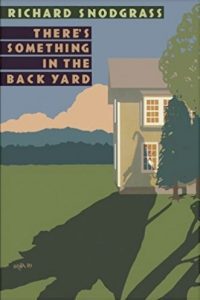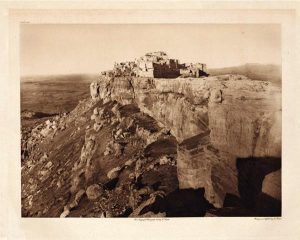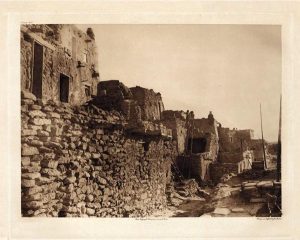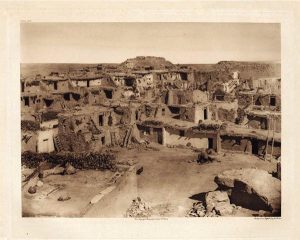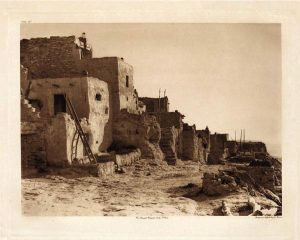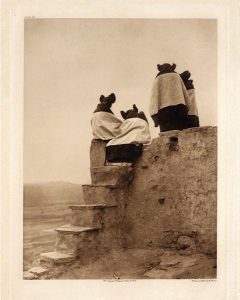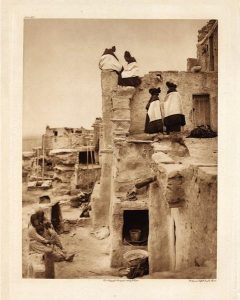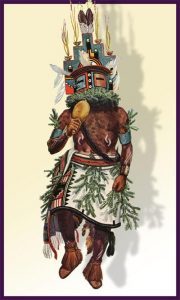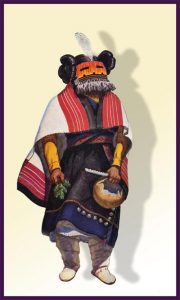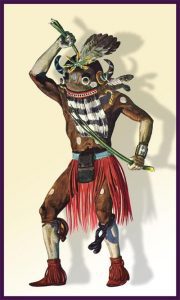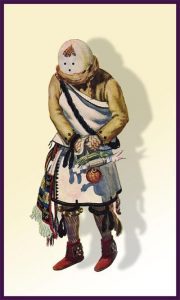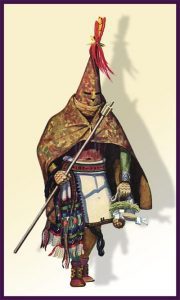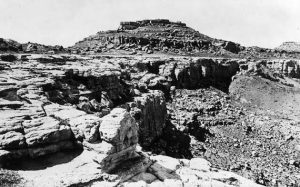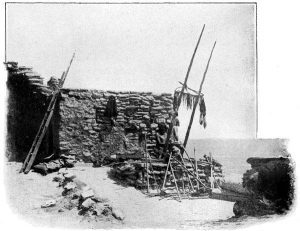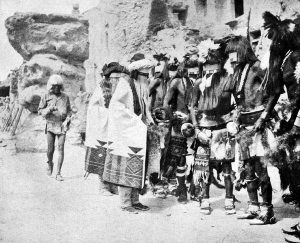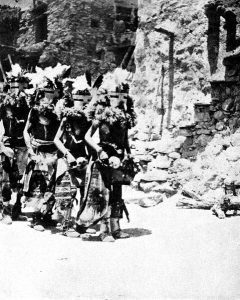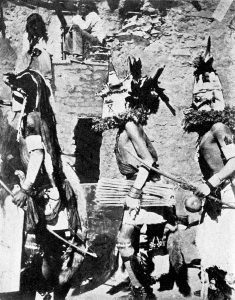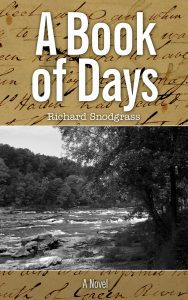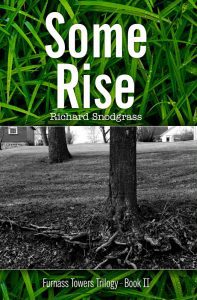H. R. Voth was a missionary and ethnologist didn’t do the American Indian culture any favors, particularly the Hopi. However, we do owe him for the survival—in some degree of truth or other; it’s entirely possible that his Indian informants gave him incorrect information—of a number of Hopi myths. As a missionary, Voth believed that the American Indians would not progress without rejecting native culture. While he saw dissolving the “heathenish culture” as his task, he studied the language, dances, and customs with zeal, publishing accounts in educational journals. In the 1890s he and his wife founded the first Mennonite mission for the Hopi at Oraibi, in Arizona. He earned a controversial reputation for forcing his way into Hopi sacred rituals and preaching loudly in the Hopi language. Again, while he focused on ending native customs, Voth carefully recorded Hopi rituals and daily life, collecting an impressive array of artifacts later loaned to the Field Columbian Museum in Chicago. In 1912 lightning struck the church he had finished in 1902, and more than a few Hopi thought that Voth’s work got what was coming to it.
The following version of the story of Aholi and other related kachinas is from H. R. Voth, The Traditions of the Hopi, Field Columbian Museum Anthropological Series, 1905. The book is in public domain and available online at Internet Archive, Biodiversity Heritage Library.
To visit website:
http://www.archive.org/details/traditionsofhopi08voth
THE AHOLI AND WALPI KATCINAS
Alíksai! In Wálpi and Sitcómovi they were living, but not at the places where the villages now are, but where they used to be. In Wálpi lived an old man, the Ahö’li Katcina. He had with him a little maiden who was his sister, the Katcín-mana.
As he was very old and feeble this maiden would always lead him. In the other village, Sitcómovi, lived a youth with his old grandmother, and as she also was very feeble he took care of her and used to lead her. One time the Ahö’li and the little maiden went to their field ‘south of Wálpi where they wanted to plant. They carried with them little pouches containing seeds. In their field was a báho shrine, and when they came to their field the Katcina first deposited some prayer-offerings in the shrine, first some corn-meal and then also some nakwákwosis which he drew forth from his corn-meal bag.
This bag he had tied around his neck. In this shrine lived Mû’yingwa and his sister Nayâ’ngap Wuhti.
“Have you come?” Mû’yingwa said. “Yes, we have come,” they replied. “Thanks,” Nayâ’ngap Wuhti said, “thanks, our father, that you have come. You have remembered us. No one has thought about us for a long time and brought some offering here, but you have thought about us.” And she began to cry. Hereupon Ahö’li gave to each one a stick upon which some nakwákwosis were strung, and also some cornmeal.
Hereupon Nayâ’ngap Wuhti was crying still more. “Yes, we have come here,” the Katcina said, “we are pitying our people because they have not had any crops for a long time, and now we thought about you here and have brought these prayer-offerings here. And now you pity them and let it rain now, and when it rains then a crop will grow again and they will have something to eat, and they will then be strengthened and revived, because they are only living a very little now.
Hereupon he took out his little bundles of seed and gave to the goddess a small quantity of yellow, blue, red, and white corn as an offering. These he placed before her on the ground. The two deities then arose. Mû’yingwa had in his left hand a móngkoho, móngwikuru, and a perfect corn-ear (chóchmingwuu). These he pointed upwards towards the sky.
The female deity held in her hand a squash, which was filled with all kinds of seeds. As Mû’yingwa pointed up the objects towards the sky; she raised the squash with both hands and then forcibly threw it on the ground on the seeds which the Ahö’li had placed there. “There,” she said, “in this way I have now planted for all of your people these seeds and they will now have crops.” Thereupon Mû’yingwa handed the objects which he held in his hand to the Katcina, saying, “You take these with you and with them you produce rain and crops for your children, the people in Wálpi.”
So the Ahö’li and the Katcín-maha returned, first going to their booth, or shelter (kísi), that was near by in the field. Here they partook of the food, which they had brought with them. “Thanks,” the Ahö’li said, “thanks that our father was willing. We shall not now go back to the village in vain.” “Yes, thanks,” the mána also said.
Hereupon they returned to the village. It was now late in the afternoon. As they passed the top of the mesa upon which Wálpi is now situated, they heard somebody singing on top of the bluff, but they went on, and arriving at their kiva they sat down north of the fireplace and smoked over the objects which they had brought with them. “Thanks that we have returned,” the Ahö’li said, ”that we have not been too late for our people. We shall now possess our people.” And as they were smoking and thus talking somebody came and entered the house. It was the youth who lived with his old grandmother in Sitcómovi.
He came in. “Thanks that you have come,” he said, “thanks that you have come and provided something for our people here,” hereupon he shook hands with them. “Sit down,” Ahö’li said, “and smoke, too.”
So the youth filled the pipe with tobacco that he had brought with him and also smoked over the objects. He took special pains to blow the smoke in ringlets upon the objects. After he had done that four times, also praying to the objects, they became moist so that the water was beginning to flow from them, indicating that their efforts had been successful and that these objects would produce rain, which was symbolized by this moisture.
Hereupon the youth prepared to return to his home, but Ahö’li restrained him and said: “Now, tomorrow when the sun rises we shall make a prayer-offering and you must do the same, because when we came we heard somebody sing away up there somewhere.” So early the next morning they dressed up in their costumes, the Katcina being dressed in a tû’ihi, a kilt, and his mask; his body also being painted nicely.
In his right band he carried a stick, natö’ngpi, to the middle of which were tied beads and a bundle of báhos. In his left hand he carried the objects which he had obtained the previous day. The mána was dressed as the Katcín-manas are yet dressed today. She carried in her left arm a tray (póta), containing different kinds of seeds. They proceeded to a báho shrine west of the present village of Wálpi, halfway down the mesa. Here they sprinkled a little meal to the sun and on the shrine, this little rite being called kúivato. As they were performing this rite they again heard the same voice singing on top of the mesa, which they had heard before.
There were then no villages on top of the mesa, but the shrine of Taláwhtoika was there already, and at this shrine someone was singing. When looking up they say that it was the Big-Horn (Wopákal) Katcina. Hereupon they returned to their house, but immediately started up on the mesa to look for and meet the one that they had heard singing. So they went up and reached the top of the mesa somewhat west of the bahóki. Here they noticed some one dressed in a white mask with very small openings for the mouth and eyes. His body was also white and he wore a thin bandoleer with blue yarn over his shoulder. He was standing by the side of the shrine shaking a rattle of bones slowly up and down.
After having shaken the rattle four times he started off. “Wait,” the Ahö’li Katcina said, “wait, we have heard some singing up here and want to see who it is.” “Yes,” the other Katcina, which was the Â’ototo, replied, “yes, I am not singing, but we are two of us here, and the other one was singing.” By this time the Big-Horn Katcina came from the west end of the mesa holding in his left hand a bow, and having a quiver strung over his right shoulder. He had a green mask with a big horn on the right side and an ear on the left.
He wore a nice kilt, nice ankle bands, and his body was painted up nicely. When he arrived at the shrine he asked the Â’ototo: “Why do you tarry here?” “Yes,” the Â’ototo replied, “these are detaining me.” “Why?” the Big-Horn Katcina asked. “We heard somebody singing here,” the Ahö’li replied, “and we came up here to see who it was, and so it is you. Now, what do you think,” he continued, “let us go down all together and then we shall possess the people,” and he told the Katcinas about what they had obtained and were going to do. So the two Katcinas were willing and they prepared to go down.
The Â’ototo took the lead and was followed by the Ahö’li Katcina, and the mána, the Big-Horn Katcina coming last. This way they went down a part of the way at a place west of the present village of Háno. Here they made a báho shrine (bahóki), erecting some stones as a mark between the villages of Háno and Sitcómovi. This shrine is still there. They then went farther down to the present gap north of Háno to the large shrine with the twisted stone which is still there, Here they met somebody coming out of that shrine and then going up and down there. It was somebody dangerous (núkpana), who had large protruding eyes and a big mouth in his mask, and many rattles around his body and along the front part of his legs. His arms were painted white, his body red. Around his shoulders he had a small blanket of rabbit skin. On his feet he had old, torn, black moccasins. In his right hand he had a large knife, in his left hand a crook, to which a number of mósililis were attached. It was the Cóoyoko, who used to kill and devour children there. When the Katcinas saw him they said to him: “Do not trouble us, we are going to possess these people here. We are going home now. You can destroy the bad ones, since you are bad anyway, but do not trouble us.
Hereupon they descended and went to their home. When they arrived at the house of the Ahö’li, which was a very beautiful house, the Ahö’li said: “Now, here we are, and you stay with us. It is not good down here it does not rain, but up there where you are it is better. When it will rain here you can go back, but we want to help the people first. So tomorrow morning we shall go to the fields and plant for the people.”
During the night they did not sleep but they were singing all night, on their masks, which they had standing in a row in the north side of the room. When the yellow dawn was appearing before sunrise it commenced to rain, and it rained hard. Towards noon the Katcinas dressed up, putting on their masks, went out, crossed the mesa, came to the fields south of the mesa, and there they beheld large fields of corn, patches filled with melons, watermelons, and squashes. Everything was growing beautifully.
Having looked around a little while they turned around, taking with them a watermelon, an ear of fresh corn, and a melon. It was still raining so that their feet sank deep into the ground.
When they arrived close to the mesa somebody met them. It was Big- Skeleton (Wokómásauwuu), who owns the earth and the fields. He lived about halfway down the mesa near the mesa point. He told the Katcinas that they should go up the mesa and prepare a house there and live there, and from there they should perform their rites. So they went up on top of the mesa and have lived there ever since.
Soon after that the Wálpi also commenced to move up the mesa and build the new village, where it is at the present time situated.
